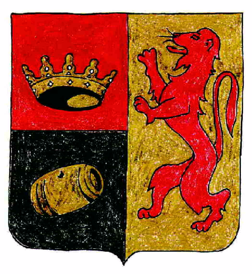The Van Keuren family, the maternal line of the Lardner sisters, was born in the Bowery.
In 1646, the Dutch government of New Amsterdam granted about 100 acres of land, located near the northeastern tip of Manhattan, to Mathij Jansen van Keulen. He and other Dutch settlers there established a "bouwerij" (Dutch for "farm"). The area eventually became known as the Bowery.
But that's the tame part of Mathij's life. Here's the exciting part ...
Henry Hudson, an Englishman working for the Dutch, had discovered the Hudson River in 1609. Four years later, a Dutch trading post was established at Esopus. In 1621, the Dutch created the Dutch West Indies Company and, three years later, began transporting Dutch settlers to Fort Orange (now Albany).
A fleet was needed to protect the settlers. To raise the needed money, the Dutch West Indies Company enrolled Principle Partners who contributed the equivalent of $3000 each (in today's US money). In return, they received commissions varying from 1/2% to 1% on the various proceeds of the colony. Perhaps the most lucrative commissions came from the "prizes" of captured Spanish ships. One such prize, for example, had a value of about $5 million.
Mathij, about 22 years old, was one of 19 Lord-Directors--Principle Partners who governed the company.
Like any corporation, as the money rolled in, it became necessary to expand. In 1630, Mathij and others formed an association to place a tenant farming colony, called Zwaanendael, along the Delaware River at the location of the current Lewes, Delaware.
But in 1632, their attention was distracted to the south, where the Dutch competed with the Portuguese to establish colonies on the coast of Brazil. The contest had continued for three years, but the Dutch lacked sufficient force to prevail. Mathij accompanied a fleet to reinforce the Dutch colonies. Upon arrival he assumed command and ordered a vigorous offensive. During 1633, the Dutch overwhelmed four Portuguese settlement along the (northern) Rio Grande River, near the eastern tip of Brazil. A fort at the mouth of the river was renamed "Van KeulensFoort".
But things were not going well back in Zwaanendael. In 1632, an Indian attack had destroyed the colony and killed all 34 of the settlers. Mathij was named Patroon of Zwaanendael, arriving there in 1636. Alas for the Dutch, the competing Swedish colony at Fort Christine, across the river, had won the favor of the Indians and the Zwaanendael colony was destroyed a second time. With the remaining settlers, Mathij traveled north to Fort Orange in 1640 where he married Margriet Hendrickse. They had four children before he died in 1648.
Margriet, born about 1624, was one of the first settlers to move from Fort Orange to Esopus in 1652. She was one of the 17 original communicants of the Dutch Reformed Church in Kingston. She was actively involved in the founding of the church and contributed the equivalent of $500 from her husband's estate in 1663. That church remains in its original location and its records provide us with much of the information we know about Mathij, Margriet and their descendants in Ulster County.
Mathij Jansen Van Keulen is thought to be the 8 x great-grandfather of the Lardner sisters, although he might actually be the 9 x great-grandfather or even 10x. We are unsure because the exact descendancy during the period of roughly 1790-1820 in Rensselaer County remains unclear.
Early Dutch names were complicated because they were patronymic and geographical. The name of Mathij, a first-born son, provides an example:
- "Mathij" is a variant of the given name of his paternal grand-father.
- "Jansen" means "son of Jan", his father's given name.
- "Van Keulen" means that the family was prominent and wealthy enough to attach to their names a label indicating that the family had roots in the city of Keulen--now in Germany and called "Cologne".
There were exceptions and complications to these practices. The key item to note is that "Van Keulen" is not the name of a family. Many unrelated families might have had their roots in Keulen.
In 1687, the British decreed an end to patronymic naming in British America. (In 1811, Napolean did the same in his empire.) Although some American descendants of Mathij have names originated in patronymic practice, many of them selected variants such as "Van Keuren" or the more American-looking "Van Curen" as their family name. It is believed that all American families with these names are descended from Mathij.
This article is primarily based on: D. G. Van Curen, Van Keulen/Van Keuren, Van Kuren/Van Curen: A Family History (Baltimore, MD: Gateway Press, 1998).
Other sources include:
- "Zwaanendael Colony," Wikipedia (https://en.wikipedia.org/wiki/Zwaanendael_Colony : 3 Nov 2017)
